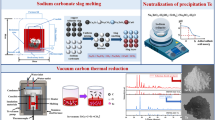Abstract
This study proposes an environment-friendly bioleaching process for recovery of metals from solders. Tin-copper (Sn-Cu), tin-copper-silver (Sn-Cu-Ag), and tin-lead (Sn-Pb) solders were used in the current study. The culture supernatant of Aspergillus niger removed metals faster than the culture supernatant of Acidithiobacillus ferrooxidans. Also, the metal removal by A. niger culture supernatant is faster for Sn-Cu-Ag solder as compared to other solder types. The effect of various process parameters such as shaking speed, temperature, volume of culture supernatant, and increased solder weight on bioleaching of metals was studied. About 99 (±1.75) % metal dissolution was achieved in 60 h, at 200-rpm shaking speed, 30 °C temperature, and by using 100-ml A. niger culture supernatant. An optimum solder weight for bioleaching was found to be 5 g/l. Addition of sodium hydroxide (NaOH) and sodium chloride (NaCl) in the bioleached solution from Sn-Cu-Ag precipitated tin (85 ± 0.35 %) and silver (80 ± 0.08 %), respectively. Passing of hydrogen sulfide (H2S) gas at pH 8.1 selectively precipitated lead (57.18 ± 0.13 %) from the Sn-Pb bioleached solution. The proposed innovative bioleaching process provides an alternative technology for recycling waste solders to conserve resources and protect environment.







Similar content being viewed by others
References
Ma, H., & Suhling, J. (2009). Journal of Materials Science, 44, 1141–1158.
Lee, J., Song, H., & Yoo, J. (2007). Resources Conservation & Recycling, 50, 380–397.
Pan, J., Wang, J., & Shaddock, D. (2005). Journal of Microelectronics and Electronic Packaging, 2, 72–83.
Yoo, K., Lee, J., Lee, K., Kim, B., Kim, M., Kim, S., et al. (2012). Materials Transactions, 53, 2175–2180.
Turbini, L., Munie, C., Bernier, D., Gamalski, J., & Bergman, D. (2004). IEEE Transactions on Electronics Packaging Manufacturing, 24, 4–8.
Ramsay, C., Lyons, T., & Hankin, S. (2002). Epidemiology, 13, 624–630.
Zhao, J. (2008). Chinese Journal of Environmental Science, 29, 2341–2344.
Cheng, C., Yang, F., Zhao, J., Wang, H., & Li, X. (2011). Corrosion Science, 53, 1738–1747.
Rohwerder, T., Gehrke, T., Kinzler, K., & Sand, W. (2003). Applied Microbiology and Biotechnology, 63, 239–248.
Xu, T., & Ting, Y. (2004). Enzyme and Microbial Technology, 35, 444–454.
Jadhav, U., & Hocheng, H. (2013). Journal of Cleaner Production, 20, 180–185.
Verstraete, W. (2002). Journal of Biotechnology, 94, 93–100.
Stefan, S., & Nicole, A. (2002). Environmental Management, 30, 68–76.
Jadhav, U., & Hocheng, H. (2014). Corrosion Science. doi:10.1016/j.corsci.2014.01.011.
Jadhav, U., Hocheng, H., & Weng, W. (2013). Journal of Materials Processing Technology, 213, 1509–1515.
Xu, T., & Ting, Y. (2009). Enzyme and Microbial Technology, 44, 323–328.
Alvarez, M., Crespo, C., & Mattiasson, B. (2007). Chemosphere, 66, 1677–1683.
Mishra, M., Pradhan, M., Sukla, L., & Mishra, B. (2010). Metallurgical and Materials Transactions B, 42, 2011–2013.
Morley, G., Sayer, J., Wilkinson, S., Gharieb, M., & Gadd, G. (1996). (Frankland J., Magan N., Gadd G., Eds.) pp. 235–256. Cambridge University Press, Cambridge.
Mulligan, C., Kamali, M., Bernard, F., & Gibbs, F. (2004). Journal of Hazardous Materials, 110, 77–84.
Anjum, F., Shahid, M., & Akcil, A. (2012). Hydrometallurgy, 117, 1–12.
Vestola, E., Kuusenaho, M., Närhi, H., Tuovinen, O., Puhakka, J., Plumb, J., et al. (2010). Hydrometallurgy, 103, 74–79.
Mecucci, A., & Scott, K. (2002). Journal of Chemical Technology and Biotechnology, 77, 449–457.
Espiari, S., Rashchi, F., & Sadrnezhaad, S. (2006). Hydrometallurgy, 82, 54–62.
Bayrak, B., Lacin, O., & Sarac, H. (2010). Journal of Industrial and Engineering Chemistry, 16, 479–484.
Aung, K., & Ting, Y. (2005). Journal of Biotechnology, 116, 159–170.
Mehta, K., Das, C., & Pandey, B. (2010). Hydrometallurgy, 105, 89–95.
Brandl, H., Bosshard, R., & Wegmann, M. (2001). Hydrometallurgy, 59, 319–326.
Amiri, F., Yaghmaei, S., Mousavi, S., & Sheibani, S. (2011). Hydrometallurgy, 109, 65–71.
Anjum, F., Bhatti, H., & Ghauri, M. (2010). Hydrometallurgy, 100, 122–128.
Acknowledgment
The current research is supported by the National Science Council of Taiwan under contract 100-2221-E-007-015-MY3.
Author information
Authors and Affiliations
Corresponding author
Rights and permissions
About this article
Cite this article
Hocheng, H., Hong, T. & Jadhav, U. Microbial Leaching of Waste Solder for Recovery of Metal. Appl Biochem Biotechnol 173, 193–204 (2014). https://doi.org/10.1007/s12010-014-0833-2
Received:
Accepted:
Published:
Issue Date:
DOI: https://doi.org/10.1007/s12010-014-0833-2




